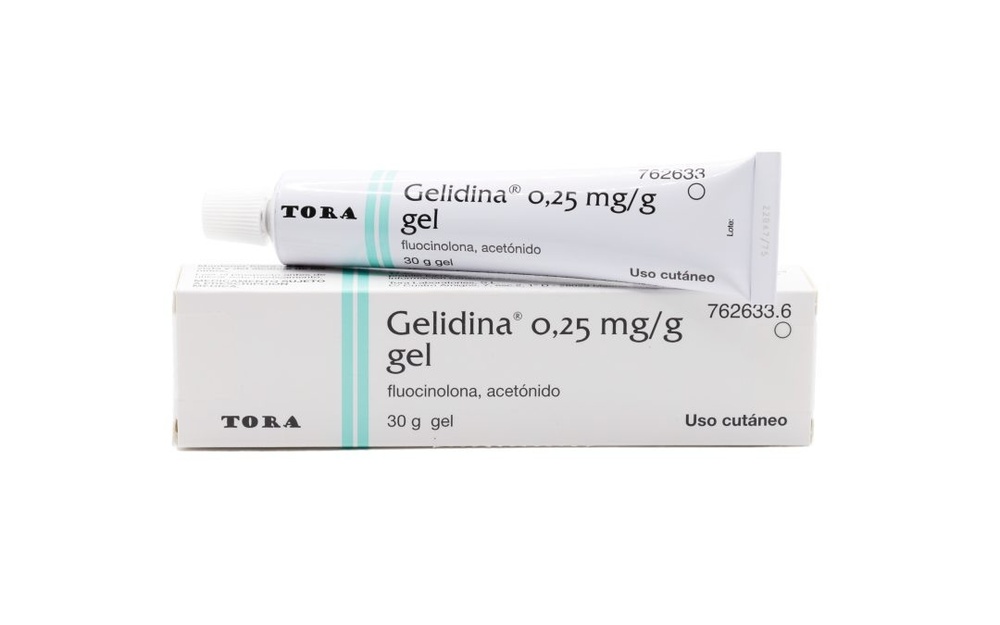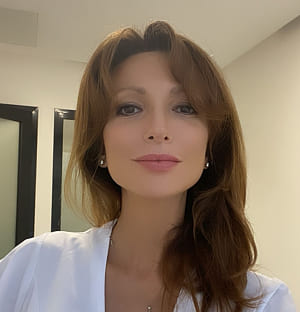

GELIDINA 0,25 mg/g GEL

Pergunte a um médico sobre a prescrição de GELIDINA 0,25 mg/g GEL

Como usar GELIDINA 0,25 mg/g GEL
Introdução
Prospecto: informação para o utilizador
Gelidina 0,25 mg/g gel
Fluocinolona, acetónido
Leia todo o prospecto detenidamente antes de começar a usar este medicamento, porque contém informações importantes para si.
- Conserva este prospecto, porque pode ter que voltar a lê-lo.
- Se tiver alguma dúvida, consulte o seu médico ou farmacêutico.
- Este medicamento foi prescrito apenas para si, e não deve dá-lo a outras pessoas, mesmo que tenham os mesmos sintomas que si, porque pode prejudicá-las.
- Se experimentar efeitos adversos, consulte o seu médico ou farmacêutico, mesmo que se trate de efeitos adversos que não aparecem neste prospecto. Ver seção 4.
Conteúdo do prospecto:
- O que é Gelidina e para que é utilizado
- O que precisa saber antes de começar a usar Gelidina
- Como usar Gelidina
- Possíveis efeitos adversos
- Conservação de Gelidina
- Conteúdo do envase e informações adicionais
1. O que é Gelidina e para que é utilizado
O princípio ativo de Gelidina é acetónido de fluocinolona. Este medicamento pertence a um grupo de fármacos conhecidos como corticosteroides tópicos (de uso externo) que atuam reduzindo a inflamação, o prurido, assim como a proliferação celular.
Gelidina é utilizado em adultos e crianças maiores de 1 ano para tratar uma ampla variedade de lesões inflamatórias, pruriginosas e alérgicas da pele, tais como: eczema, dermatite, psoríase, líquen plano e lúpus discoide eritematoso.
Este gel está especialmente destinado para o uso em zonas pilosas (de difícil acessibilidade) e lesões de zonas visíveis.
2. O que precisa saber antes de começar a usar Gelidina
Não use Gelidina
- se é alérgico ao princípio ativo ou a qualquer um dos outros componentes deste medicamento (incluídos na seção 6).
- em infecções primárias da pele e tuberculose, sífilis ou infecções virais (por exemplo, herpes ou varicela).
- se tem lesões infectadas por bactérias, vírus ou fungos, não aplique este gel em lesões infectadas.
- em áreas de pele afetadas por uma inflamação vermelha/rosada no rosto (rosácea), úlceras ou feridas, inflamação das glândulas sebáceas (acne) ou doenças cutâneas com adelgaçamento da pele (atrofia)
- em uma inflamação da pele que se dá ao redor da boca (dermatite perioral)
- em áreas da pele que mostrem uma reação vacinal, ou seja, vermelhidão ou inflamação após a administração de uma vacina
Advertências e precauções
Consulte o seu médico ou farmacêutico antes de começar a usar Gelidina.
- Se aparece uma infecção da pele, o seu médico prescreverá o tratamento adequado para essa infecção por fungos ou bactérias. Se não responde a esse tratamento, o seu médico pode suspender o tratamento até que a infecção esteja controlada.
- Este gel deve ser usado na menor dose possível, especialmente em crianças, e apenas durante o tempo estritamente necessário para aliviar a afecção da pele.
- O uso prolongado de corticosteroides tópicos, ou em dobras da pele (como as ingles ou axilas), assim como a aplicação em vendagens oclusivas (vendagem que não permite a circulação do ar ou, por exemplo, na
zona coberta por um penso), pode produzir atrofia da pele, mucosas e do tecido subcutâneo.
- O uso prolongado, de quantidades excessivas de medicamento ou em zonas extensas pode provocar a aparência de efeitos sistémicos (os que se produzem quando o medicamento se absorve e chega ao sangue), especialmente em crianças.
- Se o medicamento causar irritação, deve suspender a aplicação e consultar o seu médico.
- Deve evitar o contacto do gel com os olhos ou ao redor dos olhos, em feridas abertas ou com as mucosas (como a boca ou área genital).
- Se está em tratamento de psoríase, o seu médico deverá controlar frequentemente a sua doença a fim de observar qualquer possível piora.
- Informe o seu médico se apresenta visão borrosa ou outras alterações visuais.
População pediátrica
A administração crônica em crianças pode interferir no crescimento e desenvolvimento, por isso deve limitar-se a períodos curtos de tempo e à mínima quantidade eficaz do medicamento.
Uso em desportistas
Adverte-se os desportistas que este medicamento contém um componente, fluocinolona, que pode produzir um resultado positivo nos testes de controlo de dopagem.
Outros medicamentos e Gelidina
Comunique ao seu médico ou farmacêutico se está utilizando, utilizou recentemente ou pode ter que
utilizar qualquer outro medicamento.
Não deve aplicar outras preparações cutâneas sobre a área tratada junto com este gel.
Gravidez, lactação e fertilidade
Se está grávida ou em período de lactação, acredita que possa estar grávida ou tem intenção de ficar
grávida, consulte o seu médico ou farmacêutico antes de utilizar este medicamento.
Como regra geral, durante o primeiro trimestre de gravidez não deve aplicar este gel.
Não utilize este medicamento de forma prolongada, em zonas extensas ou com vendagens oclusivas se está grávida. O seu uso deve reservar-se a casos em que o benefício terapêutico seja superior ao possível risco.
Da mesma forma, aconselha-se precaução se se tem que empregar este medicamento durante a lactação. Não aplique o gel sobre as mamas e evite o contacto do bebê com as zonas tratadas.
Condução e uso de máquinas
Este medicamento não influi na capacidade para conduzir e/ou utilizar máquinas.
Gelidina contém parahidroxibenzoato de metilo (E-218), parahidroxibenzoato de propilo (E-216), etanol (álcool) e propilenoglicol (E-1520).
Este medicamento pode produzir reações alérgicas (possivelmente retardadas) porque contém parahidroxibenzoato de metilo (E-218) e parahidroxibenzoato de propilo (E-216).
Este medicamento contém 150 mg de álcool (etanol) em cada gramo de gel que é equivalente a 0,176 ml de etanol. Ao conter etanol, pode causar sensação de ardor na pele danificada.
Este medicamento contém 150 mg de propilenoglicol (E-1520) em cada gramo de gel. O propilenoglicol pode provocar irritação na pele.
Não utilize este medicamento em bebês menores de 4 semanas com feridas abertas ou grandes áreas de pele danificada (como queimaduras) sem consultar antes com o seu médico ou farmacêutico.
3. Como usar Gelidina
Siga exatamente as instruções de administração deste medicamento indicadas pelo seu médico ou farmacêutico. Em caso de dúvida, consulte de novo o seu médico ou farmacêutico.
O uso de gel se adapta melhor ao couro cabeludo, outras zonas corporais pilosas e lesões de zonas visíveis.
Adultos e crianças a partir de 1 ano:
Pode aplicar-se em cura aberta, como uma camada fina na zona afetada da pele, de duas a três vezes ao dia friccionando suavemente até a total absorção.
Pode também aplicar-se em cura oclusiva, como uma camada fina na zona afetada da pele, uma vez ao dia cobrindo-a com um penso plástico não poroso.
O seu médico indicar-lhe-á a duração do seu tratamento; normalmente uma semana.
Dependendo da gravidade da afecção, o tratamento pode prolongar-se de 1 a 4 semanas. Se nesse período de tempo não melhorar, o seu médico deve reavaliar o tratamento.
O tratamento não deve exceder 2 meses.
Uso em crianças
Não se recomenda o uso em crianças menores de 1 ano.
Não se recomenda o uso de penso oclusivo (como na zona do penso).
Em crianças, o tratamento deve limitar-se a períodos curtos de tempo e deve utilizar-se a mínima quantidade eficaz de medicamento. Se se utiliza no rosto, o tratamento deve ser de até 5 dias e em geral uma semana como máximo em outras zonas corporais.
Se usa mais Gelidina do que deve
O uso de quantidades excessivas de gel pode causar supressão adrenal (que origina uma alteração da
produção normal de hormonas). Neste caso, deve interromper o tratamento e o médico deve controlar a função do eixo suprarrenal hormonal.
Uma ingestão acidental pode ocasionar quadros de taquicardia (aceleração do ritmo do coração) e elevações ocasionais de tensão arterial, que cedem sem necessidade de tratamento médico.
Se utilizou este medicamento mais do que deve, consulte imediatamente o seu médico, farmacêutico ou ligue para o Serviço de Informação de Toxicologia, telefone 91-562 04 20 indicando o medicamento e a quantidade utilizada.
Se esqueceu de usar Gelidina
Não se aplique uma dose dupla para compensar as doses esquecidas.
Se esqueceu de aplicar o gel no momento previsto, faça-o assim que se lembrar e luego continue como antes.
Se tiver alguma outra dúvida sobre o uso deste medicamento, pergunte ao seu médico ou farmacêutico.
4. Possíveis efeitos adversos
Como todos os medicamentos, este medicamento pode produzir efeitos adversos, embora nem todas as pessoas os sofram.
Efeitos adversos raros (podem afetar até 1 de cada 1.000 pessoas):
- Atrofia cutânea com adelgaçamento da epiderme (a menudo irreversível)
- Teleangiectasia (dilatação de pequenos vasos sanguíneos na superfície da pele)
- Púrpura (presença de manchas e pápulas vermelhas na pele)
- Estrias na pele
- Erupções acneiformes (erupções tipo acne)
- Dermatite perioral (pequenas pápulas vermelhas ao redor da boca)
- Despigmentação da pele (perda de coloração da pele)
- Dermatite e eczema, incluindo dermatite de contacto
- Sensação de queimadura
- Efeito rebote.
Efeitos adversos muito raros (podem afetar até 1 de cada 10.000 pessoas):
- Supressão adrenal, que origina uma alteração da produção normal de hormonas.
Frequência não conhecida (não pode ser estimada a partir dos dados disponíveis):
- Hipersensibilidade (reações alérgicas)
- Prurido (coceira)
- Secura da pele
- Miliaria (alteração que se produz por obstrução dos condutos por os quais se secreta o suor, que gera a aparência de granos brancos ou vermelhos em diversas partes do corpo) ou sarpullido
- Maceraça da pele
- Hipertricose (crescimento excessivo do vello)
- Foliculite (inflamação de um ou mais folículos pilosos)
- Infecção secundária.
Comunicação de efeitos adversos
Se experimenta qualquer tipo de efeito adverso, consulte o seu médico, farmacêutico ou enfermeiro, mesmo que
se trate de possíveis efeitos adversos que não aparecem neste prospecto. Também pode comunicá-los directamente através do Sistema Espanhol de Farmacovigilância de Medicamentos de Uso Humano:
www.notificaRAM.es. Mediante a comunicação de efeitos adversos, pode contribuir para fornecer
mais informações sobre a segurança deste medicamento.
5. Conservação de Gelidina
Conservar por debaixo de 25ºC.
Mantenha este medicamento fora da vista e do alcance das crianças.
Não utilize este medicamento após a data de validade que aparece no envase após CAD. A data de validade é o último dia do mês que se indica.
Os medicamentos não devem ser jogados nos esgotos nem na lixeira. Deposite os envases e os medicamentos que não precisa no Ponto SIGRE da farmácia. Em caso de dúvida, pergunte ao seu farmacêutico como se livrar dos envases e dos medicamentos que não precisa. Desta forma, ajudará a proteger o meio ambiente.
6. Conteúdo do envase e informações adicionais
Composição de Gelidina
- O princípio ativo é acetónido de fluocinolona. Cada gramo de gel contém 0,25 mg de acetónido de fluocinolona.
- Os outros componentes são: ácido cítrico anidro E330, carbômer 940, propilenoglicol E1520, etanol 17,6% v/v (álcool), esta pequena quantidade corresponde a 150 mg, parahidroxibenzoato de metilo E218, parahidroxibenzoato de propilo E216, edetato sódico, trietanolamina, água purificada.
Aspecto de Gelidina e conteúdo do envase
Gel homogêneo transparente incolor em envase de tubos de alumínio e tampa de rosca de polietileno
(HDPE).
Apresenta-se em tubos de 30 e 60 gramas de gel.
Pode ser que apenas alguns tamanhos de envases estejam comercializados.
Titular da autorização de comercialização
Laboratórios ERN, S.A.
C/Perú, 228
08020 Barcelona, Espanha
Responsável pela fabricação
Temmler Italia S.R.L.
Via delle Industrie, 2 - 280061 Carugate – Milão - Itália
Data da última revisão deste prospecto: Outubro/2020
A informação detalhada e actualizada deste medicamento está disponível na página Web da Agência Espanhola de Medicamentos e Produtos Sanitários (AEMPS) http://www.aemps.gob.es/

Quanto custa o GELIDINA 0,25 mg/g GEL em Espanha em 2025?
O preço médio do GELIDINA 0,25 mg/g GEL em dezembro de 2025 é de cerca de 3.29 EUR. Os valores podem variar consoante a região, a farmácia e a necessidade de receita. Confirme sempre com uma farmácia local ou fonte online para obter informações atualizadas.
- País de registo
- Preço médio em farmácia3.29 EUR
- Substância ativa
- Requer receita médicaSim
- Fabricante
- Esta informação é apenas para referência e não constitui aconselhamento médico. Consulte sempre um médico antes de tomar qualquer medicamento. A Oladoctor não se responsabiliza por decisões médicas baseadas neste conteúdo.
- Alternativas a GELIDINA 0,25 mg/g GELForma farmacêutica: CREME, 0,25 mg de acetonido de fluocinolona/gSubstância ativa: fluocinolone acetonideFabricante: Tora Laboratories S.L.U.Requer receita médicaForma farmacêutica: SOLUÇÃO PARA USO TÓPICO, 0,25 mg de acetonido de fluocinolona/gSubstância ativa: fluocinolone acetonideFabricante: Tora Laboratories S.L.U.Requer receita médicaForma farmacêutica: CREME, 2 mg/g fluocinolona acetonidaSubstância ativa: fluocinolone acetonideFabricante: Tora Laboratories S.L.U.Requer receita médica
Alternativas a GELIDINA 0,25 mg/g GEL noutros países
As melhores alternativas com o mesmo princípio ativo e efeito terapêutico.
Alternativa a GELIDINA 0,25 mg/g GEL em Polónia
Alternativa a GELIDINA 0,25 mg/g GEL em Ukraine
Médicos online para GELIDINA 0,25 mg/g GEL
Avaliação de posologia, efeitos secundários, interações, contraindicações e renovação da receita de GELIDINA 0,25 mg/g GEL – sujeita a avaliação médica e regras locais.







